Holy Rollers
The floral paroxysms of paper reliquaries
Celeste Olalquiaga
While female ecstatic mysticism has been abundantly studied, the visual material produced in female cloisters, equally fervent and more tangible, is still being discovered. Particularly outstanding are the private devotional objects known as reliquaires à paperoles, glass-covered boxes filled with both human relics and ornaments made with rolled or folded paper. Dating back to at least 1643, these reliquaries usually depict a religious scene amid luscious vegetation: paste or cutout figures from Christian iconography are set with animal glue and surrounded with sacred relics, the whole immersed in a floral proliferation made mainly of paper but also including glass beads, shells, and leftover matter such as breadcrumbs. Evoking enchanted forests, these three-dimensional tableaux were produced by the thousands during the seventeenth and eighteenth centuries in Bavaria, northern Spain, and the south of France. After being discarded and forgotten for decades, they have begun to resurface in small parishes and collectors’ circles.
The flourishing of paperoles in cloistered female orders such as the Carmelites, Visitandines, and Ursulines can be framed, like much of the period’s devotional creation, between two papal councils. Reacting to the Protestant Reformation and its iconoclasm by authorizing religious iconography, the Council of Trent (1534–1565) legitimized the most contested of Catholicism’s elements—saints’ relics. Four hundred years later, the Second Vatican Council (1962–1965) would radically secularize the liturgy, resulting in a mass disposal of cult objects.
Made by the nuns as gifts for the cloisters’ sponsors or for their own families, paper reliquaries had circulated mainly in the private domain. As such, these objects of worship were part of the domestic décor, whether in the main room, a bedroom, or the private chapel of a home. They were never kept in the cloisters, as their ornamental character was at odds with monastic austerity.
Elaborated with simple materials, these reliquaries are extremely fragile: sunlight melts the waxes and glues used to fix ornaments in the boxes and fades the paper’s color, insects devour all three, and humidity and mold complete the task, becoming almost part of the scenes’ vegetal portrayal. This material fragility reiterates the triple cultural precariousness of paper reliquaries. Not only do they belong to an extremely polemical lineage—the cult of relics—but they were made by women and with “poor” materials, as female contemplative orders were forbidden from using metal or precious stones in their work. Sin of sins, paperoles’ visual exuberance made them into ornaments. It is not surprising that they were indiscriminately thrown into the garbage during the post-Council period of the 1960s and 1970s.
The prominence of paradise in both sophisticated paperoles and their rustic versions is not only decorative. Female celibacy intensified in the thirteenth century, adopting the metaphorical form of the enclosed garden or hortus conclusus of the “Song of Songs,” a miniature paradise representing perfect virtue, the place where the novice can join her “celestial husband.” After all, when Jesus rose from the dead, Mary Magdalene encountered him dressed as a gardener. Noli me tangere, touch me not, he warned her, in the midst of his metaphysical transmutation from mortal into immortal, from matter into symbol. Jesus’s sacrifice, made in the name of human redemption, is echoed in Mary Magdalene’s impossible desire to be close to a man who is becoming a ghost. This physical interdiction became the key gesture of a surrender that novices reproduce in their chastity vows. Recreating the cloister or virginal home, the hortus conclusus gives figurative shape to their devotional practice.
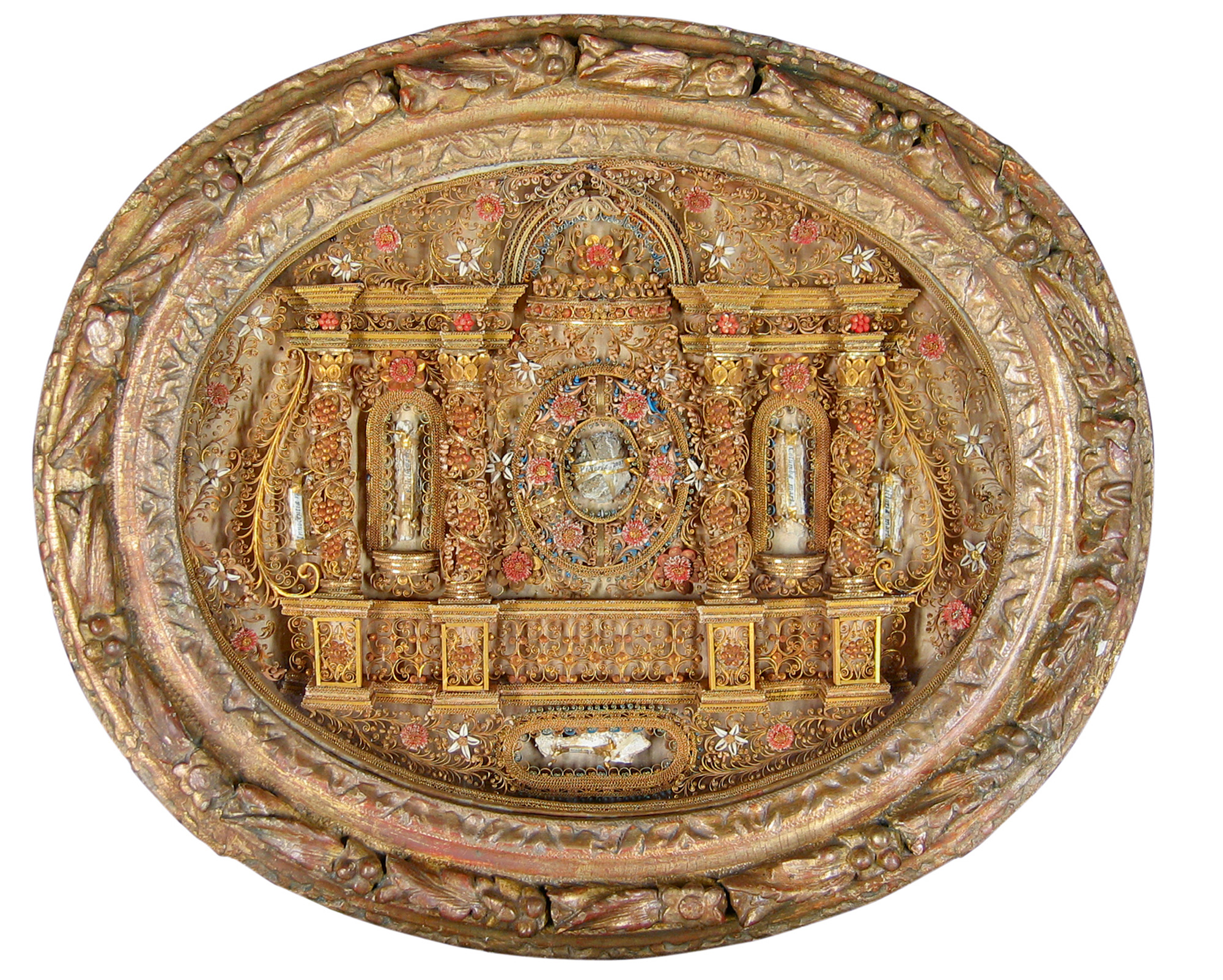
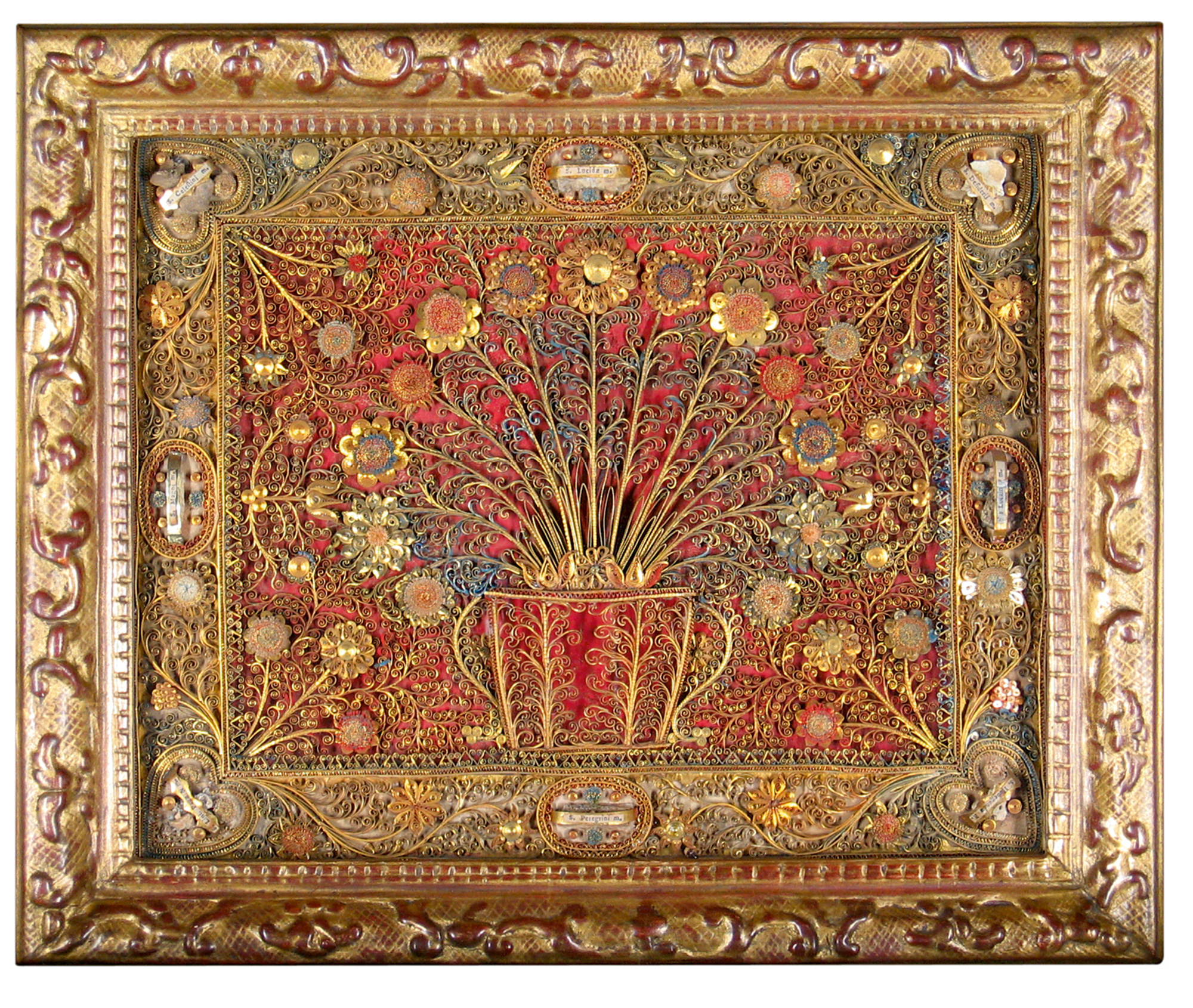
Mystical marriage is the domesticated, romantic, and joyful version of the “doloristic,” or pain-suffused, devotional trend that likewise emerged during the thirteenth century in northern Europe. Founded on the love of Christ and the contemplation of his tribulations, dolorism was centered on images of the Passion and the hardest moments of the Via Crucis (the flagellation and the Ecce Homo), giving rise to the phenomenon of stigmata (physical marks resembling the wounds of Christ’s crucified body) and mortification practices, such as scourging. Condemned because of such bodily excesses, the doloristic tradition took a gentler turn when its adherents began identifying with the women close to Christ (especially Mary and Mary Magdalene) and enacting a symbolic exchange of hearts between celestial husband and novice in the closed garden.
Feminine devotional tradition shifted in this way from a physical identification with the Passion to its metaphorical sublimation. The body remains central in this practice, although now represented in a more poetic form: the heart, organ of both terrestrial and heavenly love, object of “exchange” between Christ and the novice, the virgin and her gardener. The nuns no longer attempt to get closer to Christ by imitating his martyrdom, but rather by becoming one with him through a symbolic marriage where they are simultaneously subject, object, and place: wife, heart, and garden. It is this triad that fills the space of the reliquary with metaphorical paper flowers, since the virtues associated with virginity are so many roses or lilies forming “spiritual bouquets.”
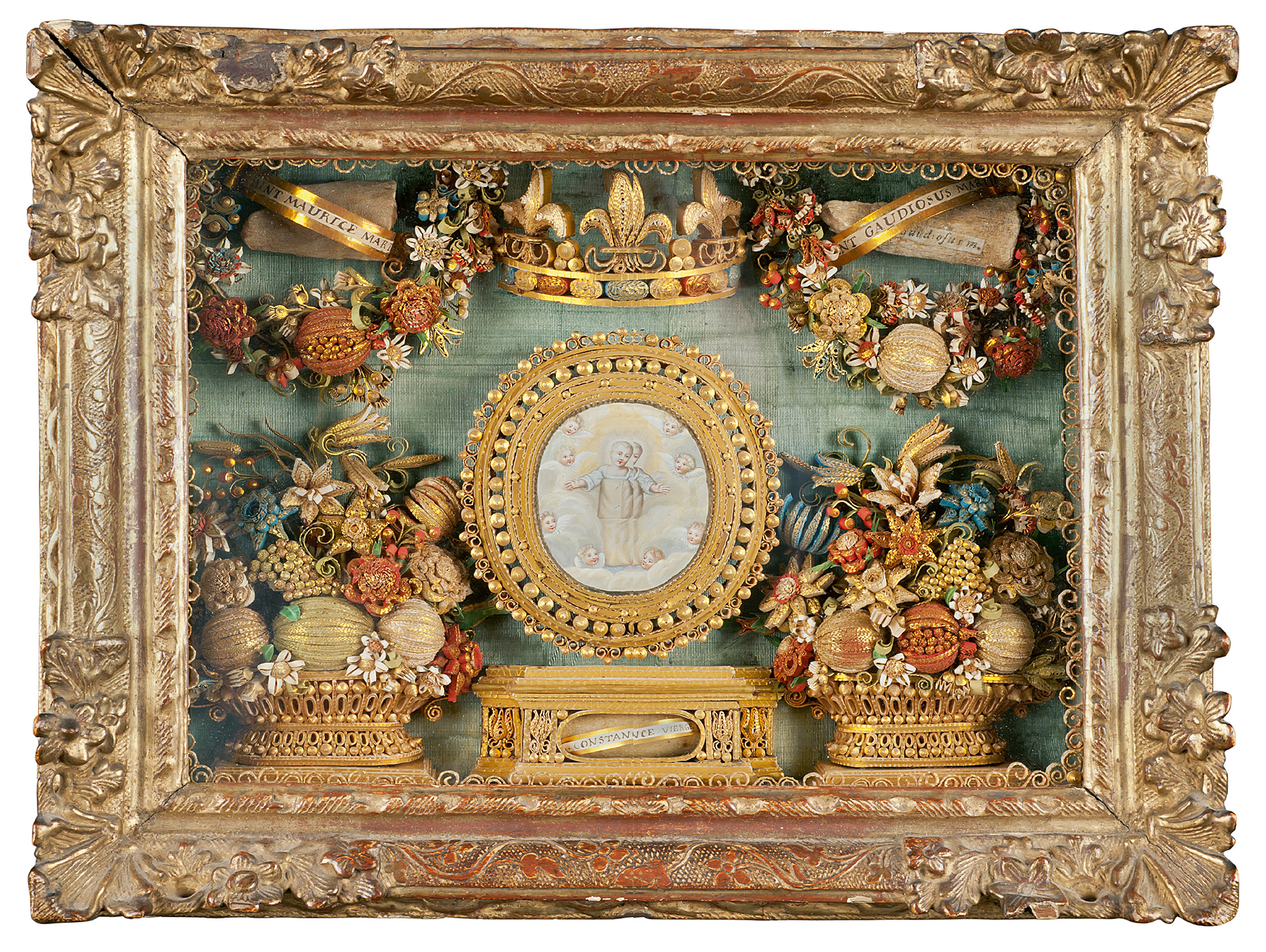
Symbols of chastity, flowers also represent the ephemeral, and by extension the superficial, side of femininity. Dismissed as decorative ornaments, flowers (and, by extension, the feminine) remain secondary in their artistic value: they are the source or object of inspiration, but rarely its authorial subject. In the reliquaries, the flowers are made with rolled paper (paperoles in French, whence their name): long, thin strips of paper of different thicknesses and colors whose edges are tinted gold and which are rolled, folded, creased, curled, and twisted to create different shapes, figures, and textures. The meticulous and repetitive elaboration of paperoles requires lengthy and involved work. It is a “manual prayer” that substitutes the tools of martyrdom, such as whips, with garlands. While the method and means are new, the desire and pleasure remain the same. The process is no longer one of a painful depuration associated with the Crucifixion, but instead its attainment in the redemption of the sinners, whose sacrifice renders them virtuous and ready for a mystical union with their husband. Going against Christian chronology, the sacrifice of Christ’s body anticipates that represented by the Virgin Mary, one of paradisiacal sexuality or rather asexuality, a “rose without thorns” because she is free of original sin.
A specular florilegium, religious scenes and paper flowers remit to one another, a semiotic mirroring that produces pictures overcharged with paradoxical meaning: virginity is represented as a proliferation of flowers that do not yield fruit, repeating to infinity an impossible gesture. Implicitly alluding to the nuns’ mystical union with Christ, this obsessive folding of paper bears the weight of their submission. Forming bunches, bouquets, vases, and even birds, the rolled paper envelops the relics, surrounds the images, frames the boxes’ margins, and is often used to build miniature altars, arcades, and columns. Producing a three-dimensional landscape with multiple perspectives, the rolled paper allows the superimposing and crisscrossing of different visual elements, resulting in a floral paroxysm that opens and closes like the smile of an accordion.
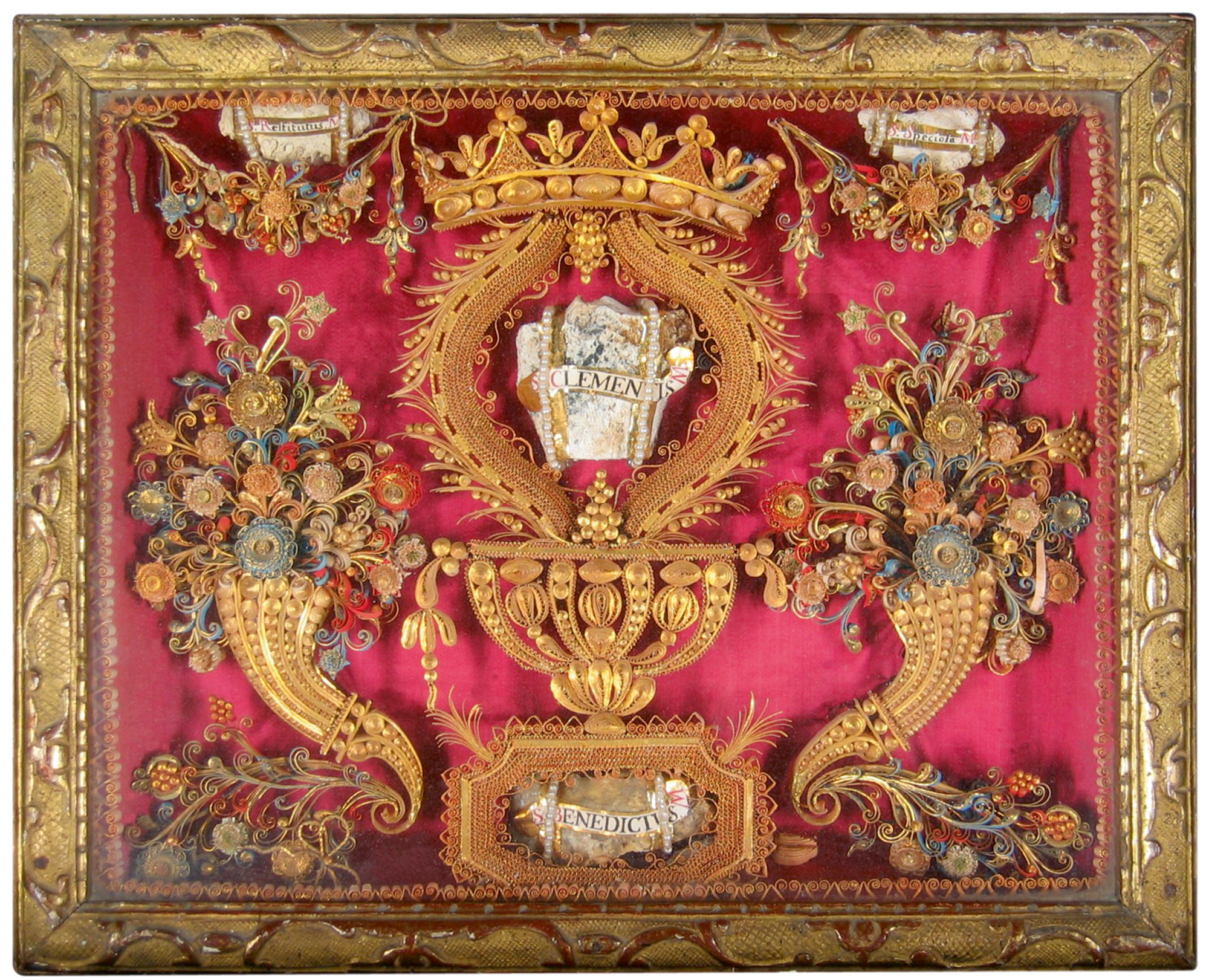
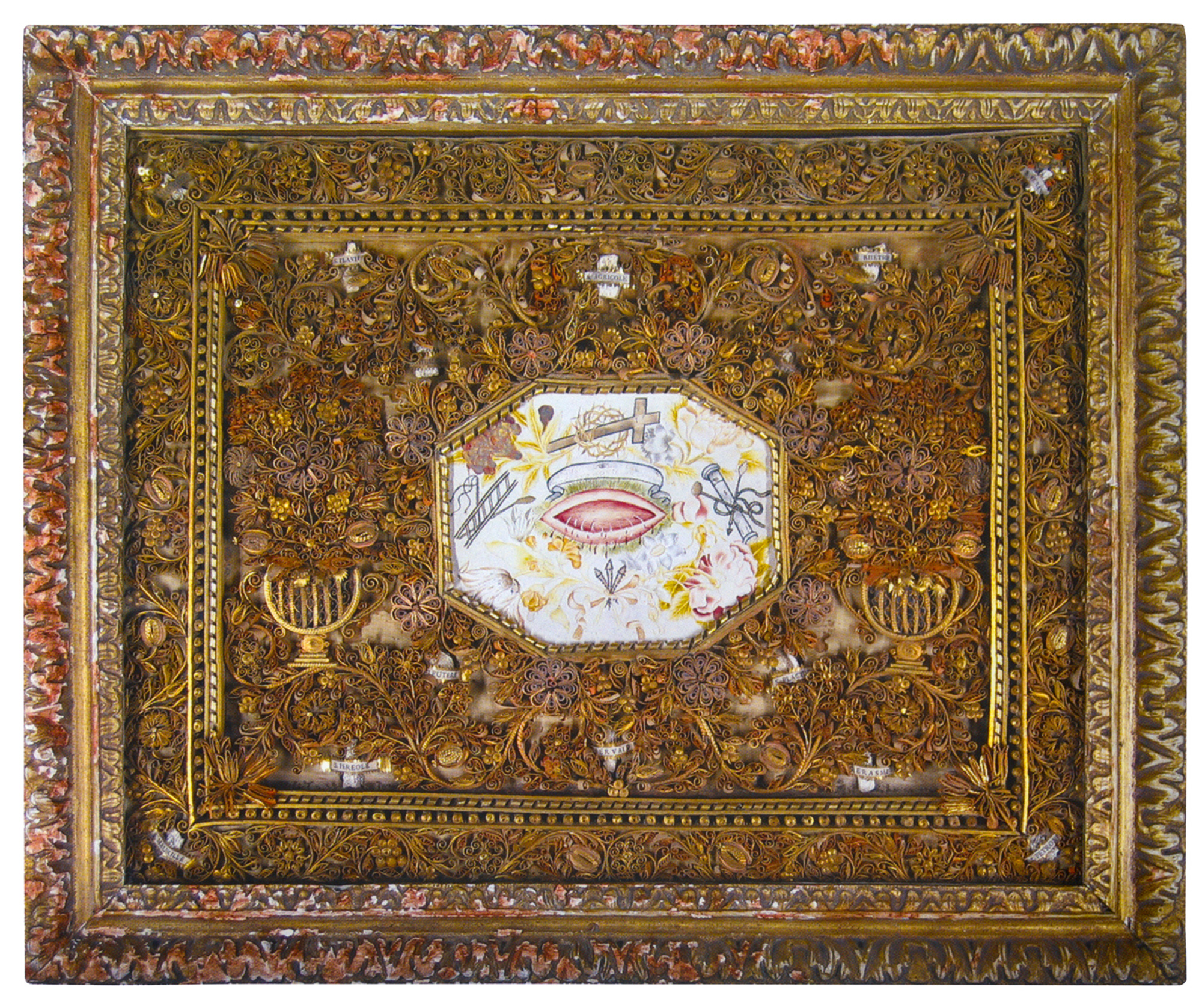
Adorning the body, as well as the home (whether ecclesiastic or laic), these ornaments fuse both with those who carry them and with their surroundings. They are intimately connected to touch—indeed, tactility is almost consubstantial to paper reliquaries, given their manual elaboration and the “ocular caress” proper to objects of worship. This visual caress is bestowed in an affectionate but also erotic sense, its object being for the maker both an instrument and sublimation of desire, whereby its doubly fetishistic character. Sexual ambivalence is therefore part and parcel of paperoles: from the moment of their inception, they are at the junction of attraction and rejection, desire and prohibition. Conceived by and through tactility, their glass casing inhibits touch, a concrete reminder of the Noli me tangere that underlies monastic practice and which is also a medical term for an ulcer or an open wound. In this sense, Noli me tangere recalls the stigmata, themselves evocative of the female vulva at stake in the paperoles’ sublimated act. The elaboration of paper reliquaries by religious women shows how their libidinous energy is projected onto the obsessive repetition of this primal scene. Narrativity, materials, and creative gestures become signs of a fundamental absence.
Similarly, one could propose the decorative or ornamental as an intermediary category between the cult object (formed at the origin of artistic expression in general, and religious and animistic expressions in particular, the initial ornatus being a religious ornament) and the exhibit-object (the modern or “laic” version of the former, now stripped of spiritual sense in favor of aesthetics). For example, the same object can transit between these two forms of cultural practice (cult or exhibit) according to time period and social use, as when religious items are exhibited in museums for their artistic value. This quality of being in-transit is operational even if it is tempting to think that the devotional, animistic, or libidinal load that makes the ornatus into a fetish surpasses its representative character, bringing it closer to the spectator, no matter who that may be.
Relics and paper flowers establish a peculiar dialogue in paperoles. The former are hard to find among the latter, and can usually only be detected via the handwritten labels indicating the names of their respective saints. Relegated to the composition’s background, relics become ornamental, while the paper flowers that surround them become sacred matter as a consequence of their proximity to these auratic remains. Manipulated and invested with myriad meanings (symbols of virtue, allegories of the Sacred Heart, “manual prayers”), paper flowers reinstate the sacred status of the ornatus. In them, form and content are inseparable: by producing a devotional charge through their narrativity and materials, but also by the silent and repetitive gesture through which they are made, paper flowers become themselves objects of worship, a veritable sacred flora. They are not a means to an end, but the end itself; more than a representation, they are a presence.
Although they combine the representational modes of both relics and icons, paper reliquaries maintain their singularity. Relics propose a spiritual link through matter, establishing a metonymical chain where the proximity to Christ happens through fragments loaded with sacred meaning. Owning or looking at relics, even if they are not touched, is a way of participating in this divine chain. Icons, by contrast, privilege a spiritual link via the intellect. The painted wooden panel is the support for a codified image that leads to a transcendental experience. There is no direct contact even if, occasionally, icons are touched.
Icons and reliquaries share a key element: the reflection or shine produced by the setting of precious stones in the metal containers of reliquaries and by the golden paint used in icons, themselves often partially covered in metal. Like the halo around the heads of saints and virgins, the glitter of these cult objects reinforces their sacred status. Shiny materials such as crystal, glass, gold, silver, and precious stones make these objects radiant, their luminescence a metaphor for the divine body. Paper reliquaries recreate these auratic effects with the difference that their presentation is a trompe l’oeil. Forbidden from using costly materials, the nuns made paperoles that reproduce the effects of traditional reliquaries and icons with ingenious methods. Relief and three-dimensionality are enhanced by juxtaposition and saturation. The concentric layers of paper petals frame the elements of the composition, surrounding the whole scene like flowery Marie-Louises or passe-partouts. The golden or silver edges of the paper slivers give the impression that these reliquaries are made of precious metals.
Ornaments that mimic the effect of ornamentation, fake decoration for a real faith, paper reliquaries and their floral plethora belong to the baroque as a style. Figurative, eclectic, and overflowing, these objects mix materials and traditions in order to induce dreamlike and fusional states, as much for those who produce them as for those who look at them. A sacred flora that veils its libidinal nature in a creative fantasy, the paper reliquary offers a unique experience of excess, as much material and visual as devotional. Religious images, relics, and paper flowers turn round and round like a carousel of paradise, pointing all the while to a primary, forbidden scene: Noli me tangere, or desire forever folding over on itself.
Celeste Olalquiaga is a cultural historian based in New York. Her books include The Artificial Kingdom: A Treasury of the Kitsch Experience (Pantheon, 1998) and Megalopolis: Contemporary Cultural Sensibilities (University of Minnesota Press, 1992). She is currently working on a re-reading of the myth of Medusa. For more information, see celesteolalquiaga.com.
Spotted an error? Email us at corrections at cabinetmagazine dot org.
If you’ve enjoyed the free articles that we offer on our site, please consider subscribing to our nonprofit magazine. You get twelve online issues and unlimited access to all our archives.